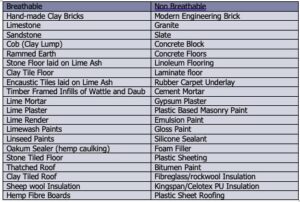Condensation:The Importance of a Breathable Wall: Ensuring a Dry and Healthy Home
Picture a traditional solid brick, block, or stone wall, approximately 9 inches thick, constructed with lime mortar and plaster. Inside your home, the temperature is a comfortable 15 degrees Celsius, while outside it may drop as low as 1 degree, particularly during the winter months. This temperature contrast creates a gradient within the wall, ranging from 15 to 1 degree.
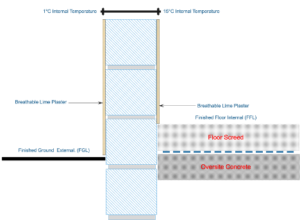
When the dew point hovers around 4 degrees, any water vapor passing through the wall will condense into liquid form and become trapped within the pores of the outer layer of the wall (highlighted in red on the illustration below). This trapped water can then escape through capillary action, moving through the lime render and eventually evaporating at the surface. Along its journey, the water may absorb chemical salts from the bricks, resulting in the white, salty deposits sometimes observed.
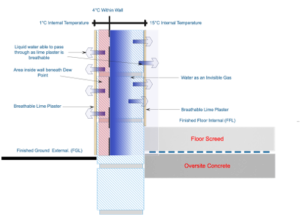
This process is dynamic, with water movement influenced by fluctuations in temperature and moisture levels throughout the day. Despite potential signs of moisture movement such as white stains or crystals, the wall remains dry. However, the scenario changes when considering a wall coated with modern plastic emulsion paint.
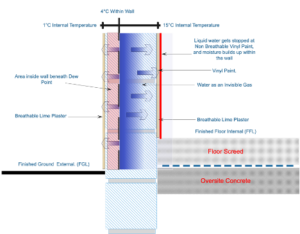
When homeowners opt for washable interior vinyl paint marketed as breathable, they may unknowingly create a barrier that hinders the escape of water vapor within the wall. While the paint may indeed be breathable at a microscopic level, the thin layer it forms can impede the passage of liquid water attempting to exit the wall. This trapped water accumulates just beneath the surface, leading to the deterioration of the plastic coating and the plaster beneath it.
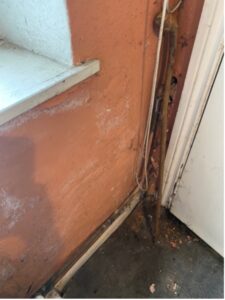
As a result, the water may cycle back and forth within the wall, carrying salts that contribute to the degradation of the paint and plaster. While the wall may exhibit signs of rising damp, the underlying issue lies in the inability of the wall to breathe properly due to the impermeable nature of the plastic paint.

So, how do we create the the environment where a wall can allow moisture, trapped within te structure to move through and evaporate? The normal route would be to call in a contractor, who will, due top lack of knowledge. try to seal the walls up further, when in fact we should be encouraging any trapped moisture out, and it seems logical to stop water in its tracks, when actually, all they are doing is moving moisture on to somewhere else and the situation continues.
They advise sealing the wall externally with cement rendered in an attempt to prevent further water getting in, not fully understanding that the moisture is not actually penetrating in the 1st place, (a full damp survey would have diagnosed this). Now water is sealed, internally and externally, with water vapour passing through the wall and condensing further, unable to escape.
This will lead to a wet, cold wall, encouraging more condensation on the inside surfaces and the process begins again and again.

All the wall ever needed was better ventilation (not uncontrolled), with background and consistent heat, but mostly it needed material that allowed water to come and go, unobstructed. This would have prevented the moisture from building up and causing problems.
By Installing and applying Non breathable materials on any surface, or worse still, both internally and externally, water is trapped within the wall, with more water being applied daily. Had the walls been left with natural breathable materials such as lime, and decorated with a lime wash, water could move freely through the structure without damage. Water only becomes a problem when its trapped and, in the scenario, described, water is well and truly trapped within a structure, that has little to no escape.
Below is a list of materials that are breathable and non-breathable.
